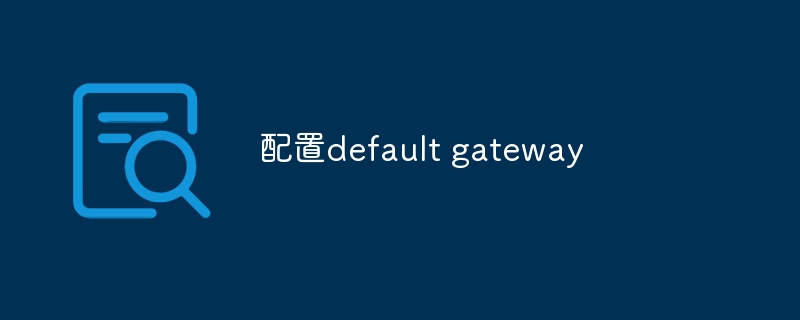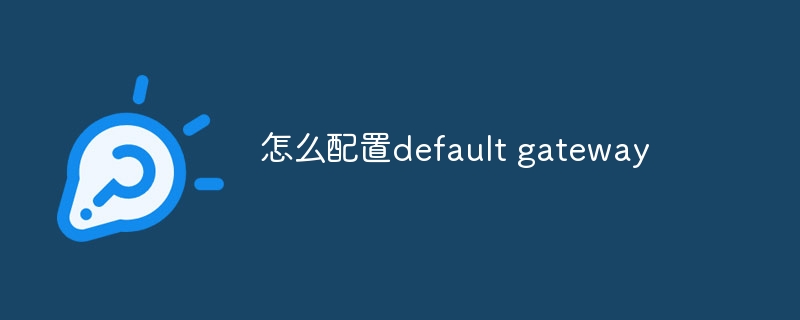504 gateway timeout solutions: 1. Check the server load; 2. Optimize the query and code; 3. Increase the timeout limit; 4. Check the proxy server; 5. Check the network connection; 6. Use load balancing; 7. Monitoring and logging; 8. Troubleshooting; 9. Add cache; 10. Analyze requests. Resolving this error often requires a combination of factors, including server performance, network connectivity, proxy server configuration, and application optimization.

"504GatewayTimeout" is a common HTTP status code that usually indicates that when the client (usually a browser) makes a request to the server, the server is waiting for another request. A server timed out when responding. This error is usually caused by the following reasons:
1. The server responds slowly: The server is processing the request, but the processing time is too long and exceeds the server's timeout limit. This may be caused by overloaded servers, complex database queries, processing large files, etc.
2. Proxy server problem: In some cases, the request may be forwarded to the backend server through the proxy server. If there is a problem with the proxy server or the configuration is incorrect, it will also cause the "504GatewayTimeout" error.
3. Network problems: There may be problems with the network connected to the server, such as network interruption, packet loss, insufficient bandwidth, etc., which will cause the request to time out.
4. Back-end service problems: Back-end servers (such as application servers and database servers) may have problems and cannot respond to requests in a timely manner.
5. Improper server configuration: The server may be improperly configured, causing the timeout limit to be too low and needs to be adjusted.
To solve the "504GatewayTimeout" error, you can take some of the following methods:
1. Check the server load: Make sure the server is not overloaded. Use server monitoring tools to view the resource utilization of the server. If the server resources (CPU, memory, disk) are exhausted, it may be necessary to upgrade the server or optimize the code.
2. Optimize queries and code: If the request requires interaction with the database, ensure that the database query and operation are efficient. Optimize query statements and use indexes to reduce response time. Also, check your application code to make sure there are no long-running operations.
3. Increase the timeout limit: If the server's timeout limit is set too low, consider increasing it. This can be done in the server configuration or proxy server configuration, depending on your architecture.
4. Check the proxy server: If you use a proxy server (such as Nginx, Apache, etc.), make sure they are configured correctly and do not cause problems. Check the proxy server logs to see if a specific request is causing the problem.
5. Check the network connection: Make sure there is no problem with the network connection between the server and the client. Check firewall settings, router configuration, and network bandwidth to see if they are sufficient.
6. Use load balancing: If your application uses multiple servers for load balancing, you can consider distributing requests to different servers to reduce the burden on each server and improve system availability.
7. Monitoring and logging: Set up a monitoring and logging system to monitor server performance and requests in real time. This can help you quickly identify problems and take steps to resolve them.
8. Troubleshooting: Carefully check the server and application logs for any error messages or warnings related to request timeouts. This may provide more clues about the problem.
9. Increase caching: Using appropriate caching strategies can reduce the number of requests to the back-end server, thereby reducing the possibility of timeout errors.
10. Analyze requests: Check the specific requests that trigger the "504GatewayTimeout" error to understand their characteristics, possible patterns, and which requests are prone to timeouts.
In short, solving the "504GatewayTimeout" error usually requires a comprehensive consideration of multiple factors, including server performance, network connection, proxy server configuration and application optimization. Taking appropriate action based on the situation can help you reduce or eliminate this error and improve the usability and performance of your website or application.
The above is the detailed content of How to solve 504 gateway timeout. For more information, please follow other related articles on the PHP Chinese website!
 Nginx timeout超时如何配置May 12, 2023 pm 10:07 PM
Nginx timeout超时如何配置May 12, 2023 pm 10:07 PMkeepalive_timeouthttp有一个keepalive模式,它告诉webserver在处理完一个请求后保持这个tcp连接的打开状态。若接收到来自客户端的其它请求,服务端会利用这个未被关闭的连接,而不需要再建立一个连接。httpkeep-alive,網頁的每一個請求都是http(圖片,css等),而打開http請求是要先建立tcp連接,而如果一個頁面每個請求都要打開及關閉一個tcp連接就會做成資源的浪費.keepalive_timeout就是當一個http請求完成,其tcp連接會存留下
 win11 clock watchdog timeout蓝屏怎么解决?Feb 14, 2024 pm 04:00 PM
win11 clock watchdog timeout蓝屏怎么解决?Feb 14, 2024 pm 04:00 PM不少的用户在升级完win11系统后会出现蓝屏的现象,例如:clockwatchdogtimeout蓝屏,那么这要怎么解决?用户们可以看看更新驱动程序或者是检查过热问题等等来进行操作,下面就让本站来为用户们来仔细的介绍一下clockwatchdogtimeout蓝屏win11解决方法吧。clockwatchdogtimeout蓝屏win11解决方法1、更新驱动程序:更新CPU和主板驱动程序可能会解决问题。可以通过访问制造商的网站下载最新的驱动程序。2、检查过热问题:过热也可能是导致此错误的原因之一
 在Vue应用中使用vue-resource时出现“Error: timeout of xxxms exceeded”怎么办?Jun 24, 2023 pm 02:21 PM
在Vue应用中使用vue-resource时出现“Error: timeout of xxxms exceeded”怎么办?Jun 24, 2023 pm 02:21 PM在Vue应用开发中,使用vue-resource进行HTTP请求是常见的操作。尽管vue-resource提供了很多方便的功能,但有时我们会遇到“Error:timeoutofxxxmsexceeded”这样的错误提示。这种错误通常是因为请求超时而导致的。那么,在这种情况下,我们应该怎样解决这个问题呢?1.增加请求超时时间首先,我们可以通过增加请
 在Vue应用中使用axios时出现“Error: timeout of xxxms exceeded”怎么办?Jun 24, 2023 pm 03:27 PM
在Vue应用中使用axios时出现“Error: timeout of xxxms exceeded”怎么办?Jun 24, 2023 pm 03:27 PM在Vue应用中使用axios时出现“Error:timeoutofxxxmsexceeded”怎么办?随着互联网的快速发展,前端技术也在不断地更新迭代,Vue作为一种优秀的前端框架,近年来受到大家的欢迎。在Vue应用中,我们常常需要使用axios来进行网络请求,但是有时候会出现“Error:timeoutofxxxmsexceeded”的错误
 504 gateway timeout怎么解决Nov 27, 2023 am 10:55 AM
504 gateway timeout怎么解决Nov 27, 2023 am 10:55 AM504 gateway timeout的解决办法:1、检查服务器负载;2、优化查询和代码;3、增加超时限制;4、检查代理服务器;5、检查网络连接;6、使用负载均衡;7、监控和日志;8、故障排除;9、增加缓存;10、分析请求。解决该错误通常需要综合考虑多个因素,包括服务器性能、网络连接、代理服务器配置和应用程序优化等。
 default gateway怎么配置Dec 07, 2023 am 11:34 AM
default gateway怎么配置Dec 07, 2023 am 11:34 AM配置default gateway的步骤:1、确定路由器的IP地址;2、打开计算机的网络配置界面;3、配置网络连接;4、配置IPv4设置;5、输入IP地址和子网掩码;6、配置默认网关;7、配置DNS服务器;8、保存设置。详细介绍:1、确定路由器的IP地址,默认网关的地址通常是路由器的IP地址,在路由器的背面或用户手册中,可以找到路由器的IP地址;2、打开计算机的网络配置等等。
 配置default gatewayDec 07, 2023 pm 03:02 PM
配置default gatewayDec 07, 2023 pm 03:02 PM配置default gateway的步骤:1、打开控制面板;2、选择网络和Internet;3、配置网络连接;4、配置IP地址;5、配置DNS服务器地址;6、确认配置;7、重启网络设备。详细介绍:1、打开控制面板,在Windows系统中,点击开始菜单,选择“控制面板”;2、选择网络和Internet,在控制面板中,选择“网络和Internet”;3、配置网络连接等等。
 怎么配置default gatewayDec 07, 2023 pm 02:56 PM
怎么配置default gatewayDec 07, 2023 pm 02:56 PM配置default gateway的步骤:1、了解网络环境;2、获取路由器IP地址;3、登录路由器管理界面;4、找到并配置WAN口设置;5、配置默认网关;6、保存设置并退出;7、检查网络连接是否正常。配置default gateway是网络设置中的重要步骤,它决定了主机通过哪个路由器访问互联网。

Hot AI Tools

Undresser.AI Undress
AI-powered app for creating realistic nude photos

AI Clothes Remover
Online AI tool for removing clothes from photos.

Undress AI Tool
Undress images for free

Clothoff.io
AI clothes remover

AI Hentai Generator
Generate AI Hentai for free.

Hot Article

Hot Tools

Dreamweaver CS6
Visual web development tools

SAP NetWeaver Server Adapter for Eclipse
Integrate Eclipse with SAP NetWeaver application server.

mPDF
mPDF is a PHP library that can generate PDF files from UTF-8 encoded HTML. The original author, Ian Back, wrote mPDF to output PDF files "on the fly" from his website and handle different languages. It is slower than original scripts like HTML2FPDF and produces larger files when using Unicode fonts, but supports CSS styles etc. and has a lot of enhancements. Supports almost all languages, including RTL (Arabic and Hebrew) and CJK (Chinese, Japanese and Korean). Supports nested block-level elements (such as P, DIV),

PhpStorm Mac version
The latest (2018.2.1) professional PHP integrated development tool

Dreamweaver Mac version
Visual web development tools





